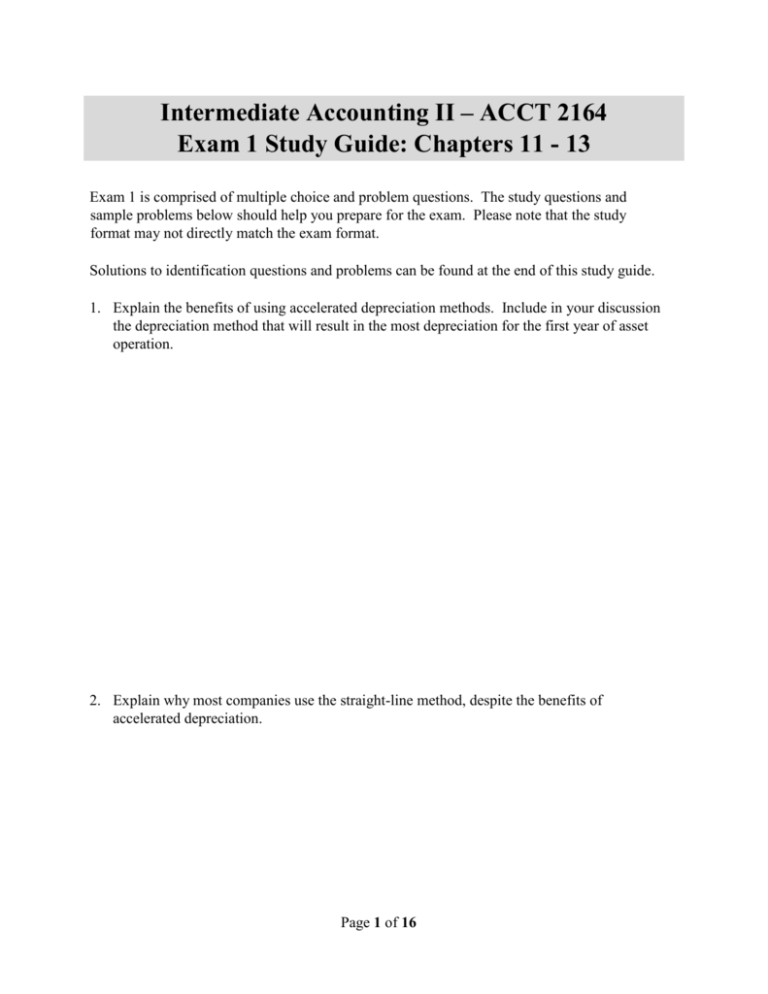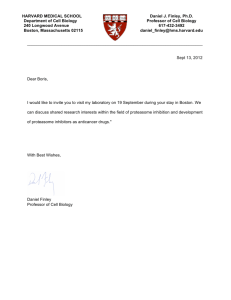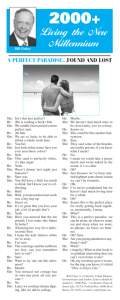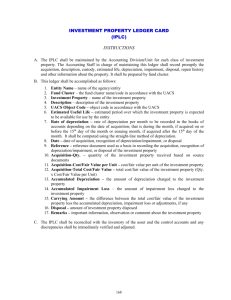Practice Exam Chapters 1
advertisement

Intermediate Accounting II – ACCT 2164 Exam 1 Study Guide: Chapters 11 - 13 Exam 1 is comprised of multiple choice and problem questions. The study questions and sample problems below should help you prepare for the exam. Please note that the study format may not directly match the exam format. Solutions to identification questions and problems can be found at the end of this study guide. 1. Explain the benefits of using accelerated depreciation methods. Include in your discussion the depreciation method that will result in the most depreciation for the first year of asset operation. 2. Explain why most companies use the straight-line method, despite the benefits of accelerated depreciation. Page 1 of 16 3. Describe when an intangible asset would not be amortized. 4. Describe the following securities categories: 5. a. Available for Sale b. Trading c. Held-to-Maturity Explain the process for accounting for asset impairment. Page 2 of 16 6. Define the following accounting terms: a. Depreciation b. Amortization c. Depletion d. Useful Life e. Residual (or salvage) Value f. Contingent Liability 7. Explain how depreciation affects an asset’s book value. Include in your discussion what an asset’s book value should be at the end of its useful life. Page 3 of 16 8. Explain when a liability would be considered a current liability and give some examples of current liabilities. 9. Describe how subsequent events should be handled. 10. Describe the following categories of investments: a. Lack of Significant Influence b. Significant Influence c. Controlling Influence Page 4 of 16 11. Explain the difference between a “realized” and an “unrealized” gain or loss. 12. Explain the difference between dividend income and interest income. Page 5 of 16 Problem 1 On January 1, 2013, Morrow Inc. purchased a spooler at a cost of $40,000. The equipment is expected to last eight years and have a residual value of $4,000. During its eight-year life, the equipment is expected to produce 250,000 units of product. In 2013 and 2014, 42,000 and 76,000 units respectively were produced. Required: Compute depreciation for 2013 and 2014 and determine the book value of the spooler at December 31, 2013 and 2014 assuming the following depreciation methods: a. b. c. d. straight-line units of production sum-of-the-years digits double-declining balance Problem 2 Eckland Manufacturing Co. purchased equipment on January 1, 2011, at a cost of $90,000. Straight-line depreciation for 2011 and 2012 was based on an estimated eight-year life and $2,000 estimated residual value. In 2013, Eckland revised its estimate and now believes the equipment will have a total service life of only six years, while the residual value remains the same. Required: Compute depreciation for 2013 and 2014. Problem 3 In 2012, Dooling Corporation acquired Oxford Inc. for $250 million, of which $50 million was attributed to goodwill. At the end of 2013, Dooling's accountants derive the following information for a required goodwill impairment test: Book value of Oxford (including goodwill) $234.5 million Fair value of Oxford $225.0 million Fair value of Oxford’s tangible and intangible assets (excluding goodwill) $204.9 million Required: Determine the amount, if any, of the goodwill impairment loss that Dooling must recognize. Page 6 of 16 Problem 4 Fryer Inc. owns equipment for which it paid $90 million. At the end of 2013, it had accumulated depreciation on the equipment of $27 million. Due to adverse economic conditions, Fryer's management determined that it should assess whether an impairment loss should be recognized for the equipment. The estimated undiscounted future cash flows to be provided by the equipment total $60 million, and the equipment's fair value at that point is $40 million. Required: Determine the amount, if any, of the impairment loss that Fryer must recognize on these assets. Problem 5 Rice industries owns a manufacturing plant in a foreign contry. Political unrest in the county indicates that Rice should investigate for possible impairment. Below is information related to the plant’s assets. Required: Determine the amount, if any, of the impairment loss that Rice must recognize on these assets. Problem 6 NSC Company engaged in the following investment transactions during the current year. June 25 July 1 July 25 Aug 1 Dec 31 Dec 31 Required: Purchased 300 shares of Volunteer Company common stock for $10 per share plus a brokerage commission of $50. These shares are classified as securities available for sale. Bought 40,000 of the 125,000 outstanding shares of Pells Company for $400,000. Goodwill of $20,000 was included in the price. Received a $1.10 per share dividend on Volunteer Company stock. Pells Company reported second-quarter profits of $50,000. Received a $.75 per share dividend from Pells Company. Volunteer Co. shares are selling for $15. Prepare journal entries to record the transactions for the year. Page 7 of 16 Problem 7 Matrix, Inc., acquired 25% of Neo Enterprises for $2,000,000 on January 1, 2013. The fair value and book value of 25% of Neo's identifiable net assets was $2,000,000 and $1,600,000 on that date, and the difference was attributable to assets that would be depreciated over 10 years. During 2013 Neo recognized net income of $500,000 and paid dividends of $400,000. Neo had a total fair value of $10,000,000 as of December 31, 2013. Required: (1) Prepare the journal entries necessary to account for the Neo investment, assuming that Matrix accounts for that investment as an equity method investment. (2) Determine the amount that would be reported for the investment on Matrix, Inc’s balance sheet as of December 31, 2013. Problem 8 On November 1, 2013, Ziegler Products issued a $200,000, 9-month, noninterest-bearing note to the bank. Interest was discounted at a 12% discount rate. Part 1 Required: 1. Prepare the appropriate journal entry by Ziegler to record the issuance of the note. 2. Prepare the appropriate journal entry to amortize the discount. 3. Determine the effective interest rate. Part 2 Required: 1. Suppose the note had been structured as a 12% note with interest and principal payable at maturity. Prepare the appropriate journal entry to record the issuance of the note by Ziegler. 2. Prepare the appropriate journal entry on December 31, 2013, to accrue interest expense on the note described in number 3 for the 2013 financial statements. Page 8 of 16 Problem 9 Finley Roofing is involved with several situations that possibly involve contingencies. Each is described below. Finley’s fiscal year ends December 31, and the 2013 financial statements are issued on March 20, 2014. 1. Finley is involved in a lawsuit resulting from a dispute with a customer. On January 25, 2014, judgment was rendered against Finley in the amount of $34 million plus interest, a total of $36 million. Finley plans to appeal the judgment and is unable to predict its outcome though it is not expected to have a material adverse effect on the company. 2. At March 20, 2014, the EPA is in the process of investigating possible environmental violations at one of Finley’s work sites, but has not proposed a deficiency assessment. Management feels an assessment is reasonably possible, and if an assessment is made an unfavorable settlement of up to $15 million is reasonably possible. 3. Finley is the plaintiff in a $80 million lawsuit filed against AA Asphalt for damages due to lost profits from rejected contracts and for unpaid receivables. The case is in final appeal and legal counsel advises that it is probable that Finley will prevail and be awarded $75 million. 4. In October 2012, the State of Montana filed suit against Finley, seeking civil penalties and injunctive relief for violations of environmental laws regulating hazardous waste. On February 3, 2014, Finley reached a settlement with state authorities. Based upon discussions with legal counsel, the Company feels it is probable that $55 million will be required to cover the cost of violations. Finley believes that the ultimate settlement of this claim will not have a material adverse effect on the company. Required: 1. Determine the appropriate means of reporting each situation. Explain your reasoning. 2. Prepare any necessary journal entries and disclosure notes. Page 9 of 16 Intermediate Accounting I - ACCT 2164 Exam 1 Study Guide: Chapters 11 – 13 Answer Key Problem 1 a. Straight-line Method b. Units of Production Method Cost Residual value Depreciable base Estimated production Depreciation per unit $40,000 4,000 $36,000 250,000 $.144 units 2013 depreciation: .144 x 42,000 units = $6,048 2014 depreciation: .144 x 76,000 = $10,944 Year 2013 2014 Cost $40,000 $40,000 Deprec. $6,048 $10,944 Accum Deprec. $6,048 $16,992 Page 10 of 16 Dec 31 Book Value $33,952 $23,008 Problem 1 (continued) c. Sum-of-the-years Digits Method Denominator = n(n + 1) 2 = (8 x 9) 2 = 36 Depreciable base = $40,000 - 4,000 = $36,000 2013 depreciation: 8/36 x $36,000 = $8,000 2014 depreciation: 7/36 x 36,000 = $7,000 d. Double-declining Balance Method Straight-line rate = 1/8 years = 12.5%. DDB = 2 x 12.5% = 25% Problem 2 Page 11 of 16 Problem 3 An impairment loss must be recognized if book value of the reporting unit acquired exceeds its fair value. In this case, it does. Book Value of Goodwill $50 million Implied Fair Value of Goodwill* Impairment Loss $20.1 million *Implied value of goodwill: FV of Oxford Less $225 million - $29.9 million FV of Oxford’s net assets 204.9 million = $20.1 million Problem 4 Since the estimated future cash flows are less than the book value of the asset, an impairment loss should be recorded. Estimated Future Cash Flows $60 million Book Value $63 million Fair Value Impairment Loss $40 million Problem 5 Since the estimated future cash flows are not less than the book value of the asset, no impairment loss should be recorded. Page 12 of 16 $23 million Problem 6 Account June 25 July 1 Debit Investment in Volunteer Co ([300 shares X $10] + $50) Cash Investment in Pells Co* 3,050 3,050 400,000 Cash July 25 400,000 Cash 330 Dividend (or Investment) Income (300 shares X $1.10) Aug 1 Investment in Pells Co 330 16,000 Investment Revenue (or Income of Pells) (40,000/125,000 shares = 32%) ($50,000 X .32 = $16,000) Dec 31 Cash 16,000 30,000 Investment in Pells Co (40,000 shares X .75) Dec 31 Credit 30,000 Fair Value Adjustment Cost $3,000 [300 shares X $10] less market $4,500[ 300 shares X $15]) Net Unrealized Holding Gains/Losses 1,500 1,500 *40,000/125,000 outstanding shares of Pells Company = 32% of the outstanding stock which indicates that the investment in Pells should be accounted for using the Equity Method. Page 13 of 16 Problem 7 (2) Investments accounted for under the equity method should be reported at their carrying value on the balance sheet. Carrying value is determined by adding all debits and deducting all credits to the Investment (asset) account. The carrying value of the Investment in Neo at year-end is $1,985,000. Investment in Neo 2,000,000 100,000 125,000 40,000 Bal 1,985,000 Page 14 of 16 Problem 8 Part 1 Account Nov 1 Debit Cash 182,000 Discount on Notes Payable ($200,000 X 12% X 9/12) Note Payable Dec 31 Credit 18,000 200,000 Interest Expense ($200,000 X 12% 2/12) Discount on Notes Payable 4,000 4,000 Effective interest rate: Discount (interest) / Proceeds [annualized] ($18,000/$182,000) X 12/9 = 13.2% Part 2 Account Nov 1 Debit Cash 200,000 Note Payable Dec 31 Credit 200,000 Interest Expense ($200,000 X 12% X 2/12) Interest Payable 4,000 4,000 Page 15 of 16 Problem 9 1. This is a loss contingency. Finley can use the information occurring after the end of the year in determining appropriate disclosure. It is unlikely that Finley would choose to accrue the $36 million loss because the judgment will be appealed and that outcome is uncertain. A disclosure note is appropriate: _______________________________ Note X: Contingency In a lawsuit resulting from a dispute with a supplier, a judgment was rendered against Finley Corporation in the amount of $34 million plus interest, a total of $36 million at January 25, 2014. Finley plans to appeal the judgment. While management and legal counsel are presently unable to predict the outcome or to estimate the amount of any liability the company may have with respect to this lawsuit, it is not expected that this matter will have a material adverse effect on the company. 2. No disclosure is required because an EPA claim is as yet unasserted, and an assessment is not probable. Even if an unfavorable outcome is thought to be probable in the event of an assessment and the amount is estimable, disclosure is not required unless an unasserted claim is probable. 3. This is a gain contingency. Gain contingencies are not accrued even if the gain is probable and reasonably estimable. The gain should be recognized only when realized. Though gain contingencies are not recorded in the accounts, they should be disclosed in notes to the financial statements. _______________________________ Note X: Contingency Finley is the plaintiff in a pending lawsuit filed against AA Asphalt for damages due to lost profits from rejected contracts and for unpaid receivables. The case is in final appeal. No amount has been accrued in the financial statements for possible collection of any claims in this litigation. 4. This is a loss contingency. Finley can use the information occurring after the end of the year in determining appropriate disclosure. Finley should accrue the $55 million loss because the ultimate outcome appears settled and the loss is probable. Loss – litigation Liability - litigation 55,000,000 55,000,000 A disclosure note also is appropriate: Page 16 of 16








